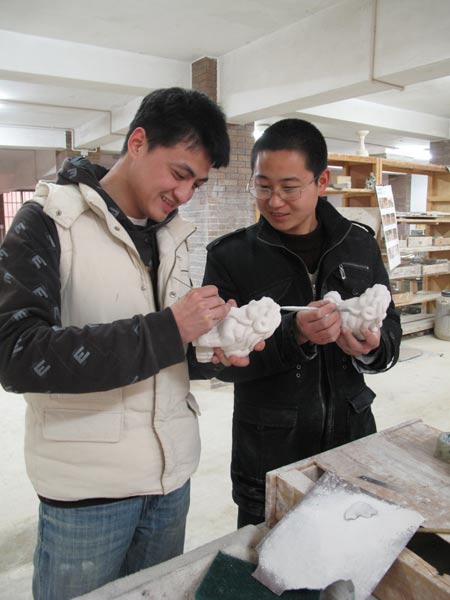'Porcelain capital' hopes to rekindle age of beauty
By Yang Wanli (China Daily) Updated: 2012-04-10 07:38Wang Yansheng, a 76-year-old artisan who specializes in making bases, is one of the workers who experienced those changes. Wang represents the fifth generation of his family to be engaged in the industry, having started work at the Jianguo Porcelain Factory, the country's first State-owned porcelain factory, at age 16.
"The factory developed out of the old imperial kilns. When it opened in 1952, it was the city's largest porcelain works. Workers there were admired because they earned nearly twice the average wage of other industries. The porcelain we made was presented as gifts to foreign leaders at the time," recalled Wang proudly.
A lack of creativity, allied to a poor competitive edge, resulted in the factory going bankrupt in the late 1990s, with only one of every 10 workers remaining in the industry. "But a private workshop is a hard place to make a profit, because of the small scale of production. Most of the workers eventually turned to other jobs, and their skills simply weren't passed on," he said.
Wang took a job at the Ancient Kiln Customs Museum, showing visitors how to make clay into bases, usually for bowls. He earns about 2,000 yuan ($317) a month, roughly as much as the average middle-school teacher.
Like Wang, 10 or more other highly experienced artisans also make a living working at the museum, repeatedly demonstrating a single step in the production process to visitors. Their skills are now simply for show, rather being part of the delicate process of creating high-quality ceramics.
The skills involved in the production of porcelain are traditionally handed on through the master-apprentice system, but Wang has only three apprentices. His 15-year-old grandson is the youngest, but he spends most of his time in school rather than perfecting his skills.
Unlike European craftsmen, who used the same basic set of ingredients but added variations in terms of colors and shapes, most Chinese artisans make their wares using a closely guarded recipe, usually passed down through generations of the same family. Although Wang realizes that a lack of interested young people will mean his skills will eventually die, he is adamant that he will continue with the master-apprentice system.
Essence of tradition
"It's impossible for us to learn the essence of traditional porcelain-making from those masters. We can only start from the very beginning, which may take 10 years or even longer," said Lei Jie, who graduated from Jiangxi Ceramic and Art Institute in 2007.
 |
|
Gao Ling (left) discusses his new work with classmate Chen Wei. Gao, who has a small workshop in the city, is confident about his creativity. Yang Wanli / China Daily |
Students also bring vitality to the old city. Every Saturday morning, a market for original wares attracts hundred of young artisans. Mostly students from Jingdezhen Ceramic Institute, they bring porcelain and ceramic works which they hope to sell.
Gao Ling, a 23-year-old senior student at the institute, has a workshop near the school. In February, he received an order to make 800 bottles for a perfume company. He said most of his classmates rent apartments nearby the school to use as workshops and almost all have their own business.
Some companies will seek out works that attract them and later place orders. "We can not compete with those old experienced artisans. Our products are not high quality, but we have new ideas," said Gao, with a confident look.
Last year, he brought a motorbike to ease travel between the school and his workshop. He also cooperated with other students who made necklaces and bracelets out of porcelain. "I knew a schoolmate who earned tens of thousands of yuan a year through his workshop business. It's a good start for young people. We can't compete with the older artisans in terms of experience, only in terms of creativity," he said.
"Modern Chinese porcelain simply doesn't enjoy the same reputation it had in ancient times. The competition among workshops now isn't about quality, it's just about lowering costs," Lei said. "It is hard to find excellent wares, let alone masterpieces, in the market."
"To make porcelain by hand allows you to feel the spiritual power inside. People now care more about how something looks than the culture behind it," said Wang Hao, a graduate of the China Academy of Art, who often shares his ideas on shapes and colors with Lei.
"Students can hardly feel the miracles hidden within the process, such as the colors, which really add an element of creativity to the products," he said.
His girlfriend has been working with him for about five years, but they are unable to buy an apartment in the downtown area, which are priced at about 2,000 yuan per square meter.
"I don't know how long I will persist, but hopefully it won't be a short period. I love it and I believe that the industry will improve in future and the city will become a really great place that will give birth to beautiful porcelain, just as it did in ancient times," he said.
- Seven villagers murdered in N China
- China steps up tobacco control efforts
- Five jailed for separatism in Xinjiang
- Letter asks for leniency in poisoning case
- Antibiotics in surface water pose 'indirect health risk'
- Tianjin airport opens up transit link to Beijing
- High levels of antibiotics in China's major rivers
- China to dig tunnel for Asian rail system
- Bering strait line to US possible, experts say
- China: Stop oil rig harassment







